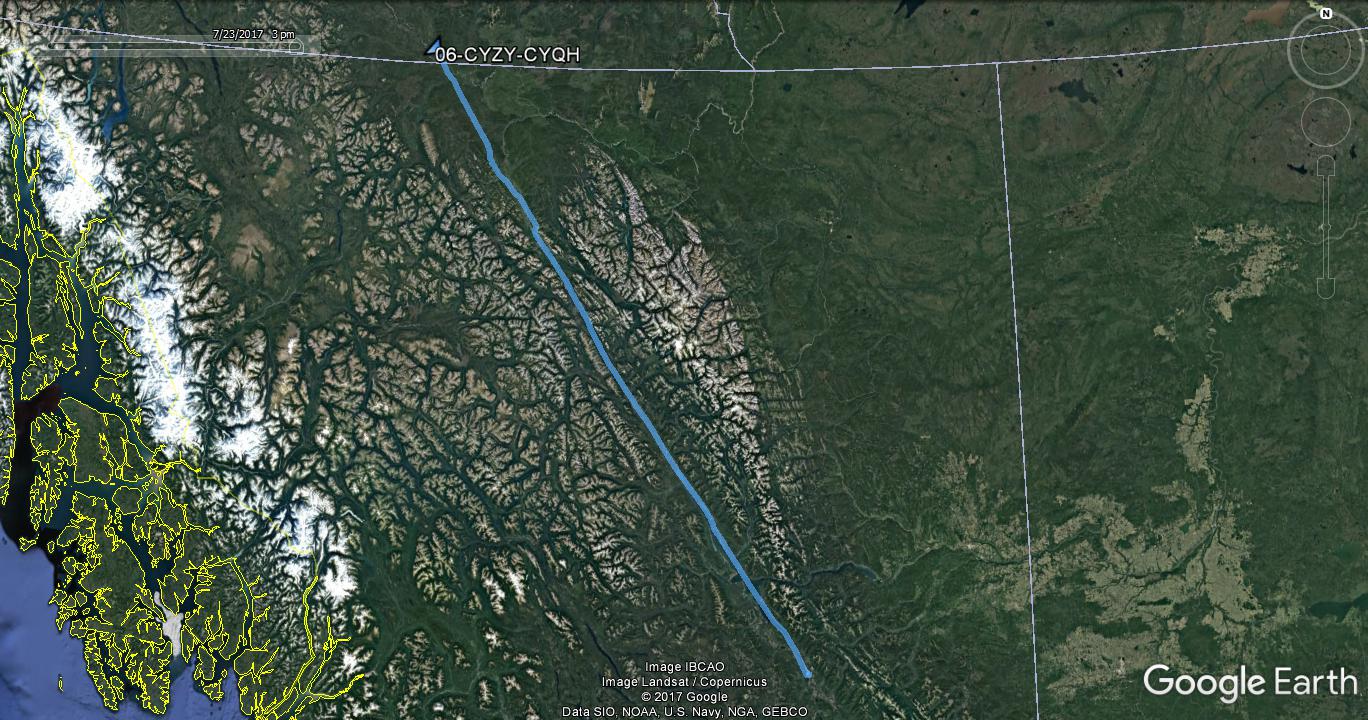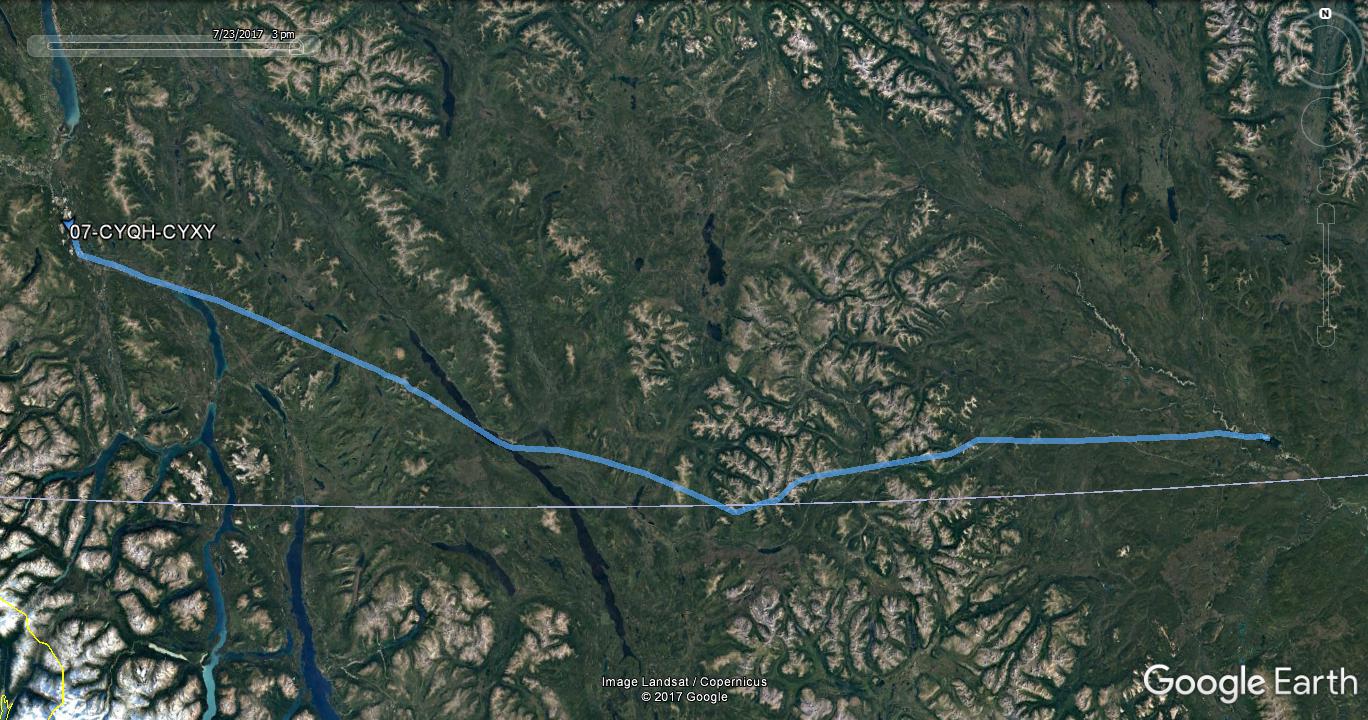I've flown up and down the Pacific coast numerous times, so the first day of the trip was routine - Montgomery Field to Redmond with a fuel stop in Carson City.
When the Alaska trip was rescheduled last year, we had already convened in Redmond, so I decided to fly up to the Canadian Rockies anyway. This gave me a chance to go through all the eAPIS and CANPASS border crossing procedures, and exercise the customs sticker I'd already purchased. As a result, this year's crossing was familiar as I was flying the same route to Kelowna.
Border crossing logistics
This AOPA webpage summarizes border crossing requirements from the US to Canada.
Aside from carrying the required documents, operationally, it amounted to:
The initial call to announce the arrival took 4 minutes with CANPASS, which was probably less time than it took to fill out the electronic eAPIS notification. I was given instructions to call CANPASS after landing at Kelowna.
When I made the call as directed after landing, I was cleared on the phone. Two trips to Canada now and I have yet to meet a Canadian border patrol agent. Interestingly, a US-registered Cirrus had landed just ahead of me, and parked on the same ramp to call CANPASS. They got a visit from a CBSA officer, who chatted with them for a few minutes. I would have figured if the officer was going to be there anyway they'd talk to me too, but nope. Cirrus pilots must be suspicious :)
"Looks like we just had our glitch for this mission"
Meanwhile, it wasn't more than a few miles across the Canadian border when the MSG indicator lit up on my GNS430 and told me "COM radio needs service". Sure enough, the radio was no longer receiving or transmitting. Thankfully, the NAV and GPS functions were not affected.
I wasn't thrilled with the idea of doing the rest of the trip with one radio, but as another pilot pointed out later, it wasn't like there was going to be that much talking to be done anyway where I was headed. Still, it was annoying not being able to monitor a second frequency such as ATIS or the Canadian FSS broadcast frequency (126.7) without leaving the local ATC frequency.
Later that afternoon, a helpful guy in Prince George did a quick (but temporary) box swap to establish that it was the unit itself, and not antennas/cables that were at issue. The unit would have to go back to Garmin at some point.
I did have a handheld COM with headset adapter, which I verified was working adequately. I went and bought an extra pack of AA batteries for it that evening.
Note: I had an oxygen tank on board, but it did not explode at any point during the trip.
| We have a problem | Storm cell approaching Prince George |
|
|
|
Heading out northwest from Kelowna, the cumulus was building up over the higher terrain. Flight service advised that some thunderstorm activity was reported in the vicinity of Prince George, but small and scattered enough to get around. As it turned out, I had to circumvent a cell that was sitting right over the river valley going into Prince George. Of course, after a wet arrival, the sun came out 30 minutes later and it became a nice day again.
I was warned that if I stopped on the FBO/terminal ramp at Prince George, I'd get hit with some sort of ramp fee. Instead, for overnight parking, I was sent to the BC Flying Club at the far end of the ramp, where there were a couple of guest parking spots for C$5/night.


The day started out with a short hop from Prince George to Mackenzie because I was told fuel was cheaper there, and it was also the last fuel available before going up the "Trench Route" to Watson Lake. Weather was fine at both ends, but there's no weather reporting on the 342nm route save for a few webcams, only one of which was working at the time. Ceilings started out around 7000MSL (5000AGL) but at one point north of Fort Ware lowered to about 5000MSL (1500 AGL) in showers. I was starting to worry the pass would be socked in, when a bright hole became evident and I could see into the next valley. Soon enough I was in sunshine flying over some beautiful lakes. One, Scoop Lake, is the home of a hunting lodge and uncharted private airstrip that's known for being a good emergency landing site.
| Williston Lake | North of Fort Ware |
|
|
|
| Scoop Lake | Birches Lake |
|
|
|
Up until Watson Lake, the airports I've landed at in Canada were either towered or uncontrolled (Airport Traffic Frequency, ATF, only). Watson Lake had a Mandatory Frequency (MF) which was a hybrid of the two. Unlike airports with an ATF, where radio calls were recommended, use of the MF, as the name implies, is mandatory. Many airports with an MF are staffed with an on-field radio operator who will relay weather and traffic information (but not provide control). As I learned when I made the request at Watson Lake, although they are addressed as <Field name> Radio, they were not Flight Service and I still had to close my flight plan on an FSS RCO.
What is polar survival equipment anyway?
On the ground at Watson Lake, I called Flight Service to file a flight plan for my next leg to Whitehorse. One of the ICAO flight plan items is whether you carry any survival gear, and what type (polar, maritime, jungle, desert) it is. I have looked for formal definitions of the survival gear types in the past without success - all references I could dig up were merely recitations of instructions for marking out the boxes on the ICAO form as appropriate (e.g. "CROSS OUT indicator P if polar survival equipment is not carried"). But what exactly was "polar survival equipment"? I took the opportunity to ask the briefer. He referred to the AIP Canada, then noted that while it gave a list of suggested equipment, it didn't explicitly define what constituted polar, maritime, or the other categories. He told me he would look for an answer and to call back when I reached Whitehorse. When I called back, he indicated that he hadn't yet found a formal definition and was asking around. Apparently, it used to be in the AIP Canada, but at some point the document was updated and the details were removed. I've been meaning to follow up with him now that I'm back home, but haven't yet. With adoption of the ICAO flight plan form in the US around the corner, I can't be the only one wondering what the formal definitions of survival equipment are... can I? If you know the answer, please let me know!
While I was taxing for departure after refueling at Watson Lake, two transiting aircraft called passing overhead. I didn't hear anything more from them as I flew west. Eventually, it clouded over again and started showering, but there was plenty of room underneath to get into Whitehorse (CYXY). It turned out the two earlier aircraft were Bonanzas, and I found myself arriving in Whitehorse right behind them. They had flown across from the East Coast, also enroute to Alaska, and also planning on two nights in Whitehorse. Great! Dinner company and flying buddies for the next leg!
I went with the first FBO I called at Whitehorse - Alkan Air, and while I usually ask about overnight rates, I neglected to do so here. It turned out to be C$75/night, which felt steep. They did waive one night of parking with fuel purchase.
Planned rest day in Whitehorse, which was convenient because it was under a 600 ft ceiling all day. I did some hiking in the local area, though the popular Gray Mountain reserve and trail had its head in the clouds so I skipped it.